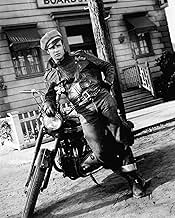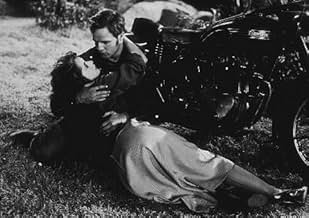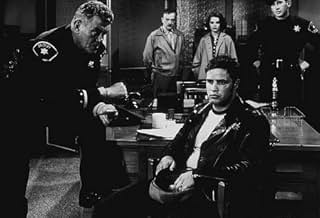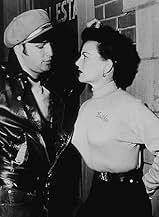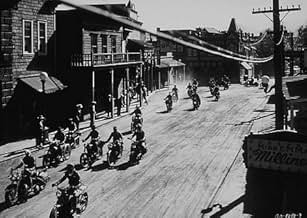Two rival motorcycle gangs terrorize a small town after one of their leaders is thrown in jail.Two rival motorcycle gangs terrorize a small town after one of their leaders is thrown in jail.Two rival motorcycle gangs terrorize a small town after one of their leaders is thrown in jail.
Wally Albright
- Cyclist
- (uncredited)
Chris Alcaide
- Deputy
- (uncredited)
Don Anderson
- Stinger
- (uncredited)
Robert Bice
- Wilson
- (uncredited)
- Director
- Writers
- All cast & crew
- Production, box office & more at IMDbPro
Storyline
Did you know
- TriviaThe Triumph motorcycle that Marlon Brando rides in the movie was his personal bike.
- GoofsAt the completion of the opening credits, when the view switches to the wide shot of the pack preparing to make a left turn, the lead bike (Johnny) already has the trophy tied to the headlight. Johnny isn't presented with the stolen trophy until a later scene at the races.
- Crazy credits[Opening credit] This is a shocking story. It could never take place in most American towns -- But it did in this one.
It is a public challenge not to let it happen again.
- ConnectionsEdited into Heavy Petting (1989)
Featured review
Would this movie still be watched but for Brando's performance? I think not - it would be relegated to the scrap heap of old B movies. But Brando carries the movie by having the right qualities to play Johnny Strabler, the leader of a motorcycle gang that creates havoc in a small California town. Brando plays Johhny with sullen, smoldering rebelliousness with a suggestion of depth and vulnerability underneath. Brando had already shown his abilities in "A Streetcar Named Desire" and was soon to make "On the Waterfront." The performance here is not up to those standards, but it is engaging. At the time he made this movie Brando's star power was such that he could name his roles, so it is interesting to speculate why he chose to make this. Maybe this role appealed to his own rebellious spirit.
The movie is dated for sure, but you may learn some things about the 1950s that you won't find in the history books. Many early 50s anachronisms are in evidence: 78 records on the jukebox, references to television as being new, bebop music and argot, local HUMAN telephone operators. The comment the old bartender makes about the advent of TV is prescient, "Everything is noise and pictures, nobody talks to anyone anymore" - there is more truth to that with each passing decade. The score - generic, loud, obvious, and intrusive - would not be accepted in contemporary movies. Johnny's attempt to be cool by snapping his fingers to music on the jukebox is so phony as to be embarrassing. One interesting thing was to see an early version of the high-five in response to the interjection "pop me." But credit must be given for this being one of the first mainstream movies to treat the rebellion against the claustrophobic conformity and cold war angst of the early 50s. It was unique for its time.
We do not get much motivation for the reasons the gang members behave the way they do. There are mighty few specifics about the guys in the gang - where they come from, how they support themselves, or what they do besides terrorize small towns. We get only a hint of Johnny's past when, during a beating by the locals he says, "My old man used to hit harder than that." But, maybe all we need to know comes from Johnny's extolling the feeling he gets when getting on his cycle to "just go."
There are many memorable scenes, like the one where Johnny is asked if he doesn't want to thank some people who have done him a good deed and he comes to an inarticulate stop only to have his woman friend say, "That's okay, he doesn't know how."
Lee Marvin has a good go playing Chino, the head of a rival gang that had split off from Johnny's. Chino is the more stereotypical bad ass. He may not have the complex personality of Johnny, but Marvin seems to be having such a grand time in playing him that it is hard not to share in the fun.
There is some interesting photography such as the opening scene where the cyclists roar right over the camera placed in the center of the road. And there is some good night-time black and white work as well.
In an era of drive-by shootings, heavy drug trafficking, and internet pornography the events in this movie can seem pretty tame, but one should not underestimate the number of themes addressed - ones that are still relevant: standing up to intimidation, vigilantism, the desire for freedom, misinterpretation of behavior (with unfortunate consequences), the proper use of force, sex, crowd behavior, generational conflicts and confusions, the ills of stereotyping, and greed.
Also, one lesson to be learned is that steatopygous actors should not wear tight jeans.
The movie is dated for sure, but you may learn some things about the 1950s that you won't find in the history books. Many early 50s anachronisms are in evidence: 78 records on the jukebox, references to television as being new, bebop music and argot, local HUMAN telephone operators. The comment the old bartender makes about the advent of TV is prescient, "Everything is noise and pictures, nobody talks to anyone anymore" - there is more truth to that with each passing decade. The score - generic, loud, obvious, and intrusive - would not be accepted in contemporary movies. Johnny's attempt to be cool by snapping his fingers to music on the jukebox is so phony as to be embarrassing. One interesting thing was to see an early version of the high-five in response to the interjection "pop me." But credit must be given for this being one of the first mainstream movies to treat the rebellion against the claustrophobic conformity and cold war angst of the early 50s. It was unique for its time.
We do not get much motivation for the reasons the gang members behave the way they do. There are mighty few specifics about the guys in the gang - where they come from, how they support themselves, or what they do besides terrorize small towns. We get only a hint of Johnny's past when, during a beating by the locals he says, "My old man used to hit harder than that." But, maybe all we need to know comes from Johnny's extolling the feeling he gets when getting on his cycle to "just go."
There are many memorable scenes, like the one where Johnny is asked if he doesn't want to thank some people who have done him a good deed and he comes to an inarticulate stop only to have his woman friend say, "That's okay, he doesn't know how."
Lee Marvin has a good go playing Chino, the head of a rival gang that had split off from Johnny's. Chino is the more stereotypical bad ass. He may not have the complex personality of Johnny, but Marvin seems to be having such a grand time in playing him that it is hard not to share in the fun.
There is some interesting photography such as the opening scene where the cyclists roar right over the camera placed in the center of the road. And there is some good night-time black and white work as well.
In an era of drive-by shootings, heavy drug trafficking, and internet pornography the events in this movie can seem pretty tame, but one should not underestimate the number of themes addressed - ones that are still relevant: standing up to intimidation, vigilantism, the desire for freedom, misinterpretation of behavior (with unfortunate consequences), the proper use of force, sex, crowd behavior, generational conflicts and confusions, the ills of stereotyping, and greed.
Also, one lesson to be learned is that steatopygous actors should not wear tight jeans.
Details
- Runtime1 hour 19 minutes
- Color
- Aspect ratio
- 1.37 : 1
Contribute to this page
Suggest an edit or add missing content






